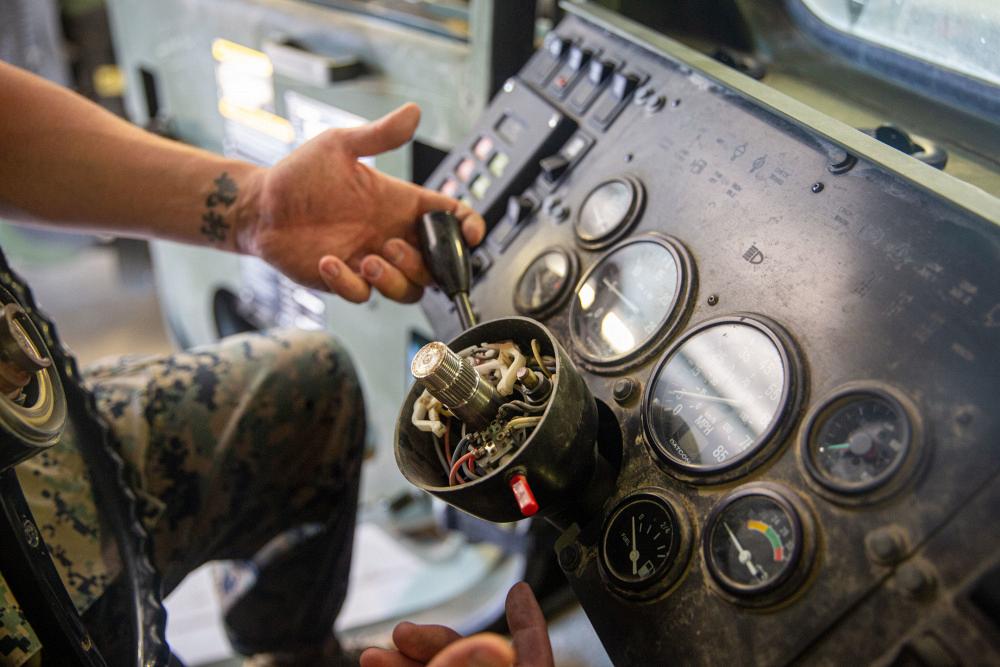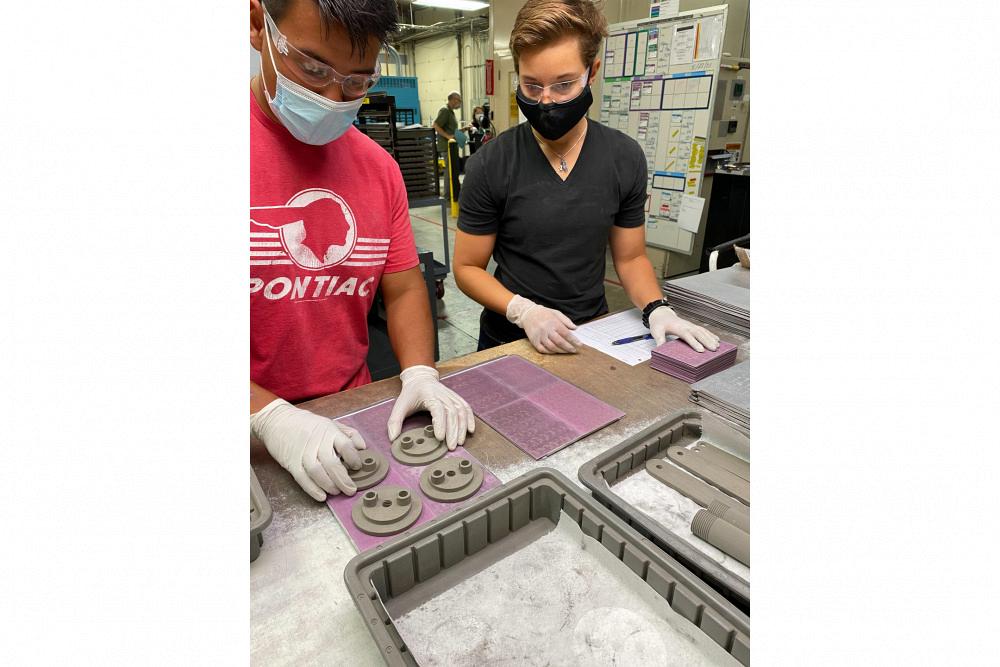- FMA
- The Fabricator
- FABTECH
- Canadian Metalworking
Our Publications
Categories
- Additive Manufacturing
- Aluminum Welding
- Arc Welding
- Assembly and Joining
- Automation and Robotics
- Bending and Forming
- Consumables
- Cutting and Weld Prep
- Electric Vehicles
- En Español
- Finishing
- Hydroforming
- Laser Cutting
- Laser Welding
- Machining
- Manufacturing Software
- Materials Handling
- Metals/Materials
- Oxyfuel Cutting
- Plasma Cutting
- Power Tools
- Punching and Other Holemaking
- Roll Forming
- Safety
- Sawing
- Shearing
- Shop Management
- Testing and Measuring
- Tube and Pipe Fabrication
- Tube and Pipe Production
- Waterjet Cutting
Industry Directory
Webcasts
Podcasts
FAB 40
Advertise
Subscribe
Account Login
Search
Marine logistics team 3D-prints a device that stops steering wheels from breaking during maintenance operations
- June 22, 2021
- News Release
- Additive Manufacturing

The steering wheel of a Marine vehicle has been traditionally removed with a 10-way slide hammer. Often, the steering column cracked. A Marine designed and 3D-printed a tool that eliminates the breakage. Gunnery Sgt. Michele Hunt
The following article was posted to the Defense Visual Information Distribution Service website.
Marine Corps Systems Command’s Advanced Manufacturing Operations Cell (AMOC) have collaborated with the 1st Supply Battalion and industry partners to develop a 3D-printed metal device for removing steering wheels. The innovative tool helps solve a common problem among Marines who perform vehicle maintenance.
“We’re always talking about how Marines move toward the sound of gunfire,” said Capt. Matthew Audette, AMOC project officer at MCSC. “If we open up that aperture a little bit, we can say Marines move toward the sound of problems, and they solve those problems. Additive manufacturing lowers the barrier to entry for physically making that solution.”
Marines need to remove the steering wheel columns for the Medium Tactical Vehicle Replacement and Logistics Vehicle System Replacement when conducting vehicle maintenance. The removal tool that comes with their maintenance kit, a 10-way slide hammer, requires users to exert a great deal of pressure on the steering wheel column. This often leads to the steering wheel being broken or damaged.
“There are tools that already remove the steering wheel,” said Audette. “But they have a high percentage of breaking the steering wheel in the process.”
Once a steering wheel is damaged, Marines must order a replacement part. Typically, the lead-time for a replacement part is 25 days, taking the vehicle out of service. With additive manufacturing, Marines can create solutions in a fraction of the time. Tools produced through additive manufacturing, like the steering wheel removal device, help decrease maintenance time and increase readiness.
Staff Sgt. Kyle Owens, a motor transportation chief with 1st Marine Logistics Group, designed and developed the first steering wheel removal device out of sheer frustration. The innovative tool won him an Operational Agility Team award for the Innovation Challenge.
“I was a young corporal working on trucks, and I was tired of getting chewed out for breaking the wheel,” said Owens. “I was bored at lunch with my buddy one day, and we just started brainstorming a better way we could get the steering wheel off without breaking it every time.”
Owens developed his initial prototype in 2012 using scrap metal and washers he found at his motor pool. Last year, he had the opportunity to collaborate with his unit’s innovation officer to create a prototype of his device using additive manufacturing.
“My biggest [concern] was figuring out if there was a way to make more, so that the lance corporals and corporals under me wouldn’t have to deal with some of the same challenges I did,” said Owens. “If I can help make their life easier, that’s all that matters, because I know what it’s like to be that young Marine getting in trouble for breaking something.”

Cpl. Oscar De La Cruz (left) and Cpl. Elizabeth Patterman stack green 3D-printed parts in preparation for debinding and sintering them at the facility of an additive manufacturing company in Petaluma, Calif. Morgan Blackstop
Owens collaborated with Cpl. Aiden Bemis, a digital manufacturing engineer with 1st Supply Battalion, and engineers with AMOC to design and print the tool. They developed multiple iterations of the prototype in polymer before transitioning to metal.
“We began developing the prototypes in polymer because those are the typical 3D printers across the Marine Corps enterprise,” said Kristin Holzworth, AMOC’s chief scientist at Marine Corps Systems Command (MCSC). “It’s an economical and affordable approach to prototyping while you are refining the design.”
After Bemis completed a form, fit, and function check of the polymer tool, the team proceeded to the metal component development. The Marine Corps worked with industry partners specializing in metal additive manufacturing to create the final prototype. The metal printer takes about a day to print each batch of steering wheel removal devices and yields 36 devices per batch.
AMOC facilitated the arrangement among 1st Supply Battalion, MCSC, and two industry partners for final approval of the tool. After the prototype was refined and ready to print, Marines sent the design to AMOC for approval and inclusion in MCSC’s additive manufacturing digital repository.
AMOC approved the steering wheel removal device as an enterprise-wide Marine Corps solution. Marines interested in printing and using their own can find the tool’s blueprints in MCSC’s digital repository.
The repository is a secure website where Marines can upload their part designs for approval and share with their fellow Marines across the globe. It has approximately 500 replacement parts designed by Marines, said Audette.
Advanced manufacturing provides the Marine Corps with additional flexibility. This manufacturing method encompasses additive manufacturing, welding, laser-cutting, drone-building, and other services that meet the warfighter’s needs in a timely fashion.
Traditionally, Marines were confined to the equipment and resources on hand. Advanced manufacturing allows units to print items as needed.
“[Advanced manufacturing] supports Force Design 2030 as it lightens the load logistically,” said Audette. “As we put additive manufacturing and other advanced manufacturing capabilities into the maintenance battalions, we can go through and design one-off parts based on a hyper-specific need that we only need one or two of.”
AMOC, which the Marine Corps established in 2019, provides 24/7 3D printing help-desk support for the fleet and program offices. It also manages the parts-approval pipeline for ground-equipment replacement parts created by Marines.
“AMOC is essentially the Corps’ on-call nerds,” said Audette. “There is not a lot of expertise throughout the Marine Corps in advanced manufacturing because it is a newer technology. As people are becoming more familiar with it, we are the on-call experts for anybody in the Marine Corps to reach out and tap into.”
- Podcasting
- Podcast:
- The Fabricator Podcast
- Published:
- 04/16/2024
- Running Time:
- 63:29
In this episode of The Fabricator Podcast, Caleb Chamberlain, co-founder and CEO of OSH Cut, discusses his company’s...
- Trending Articles
- Industry Events
16th Annual Safety Conference
- April 30 - May 1, 2024
- Elgin,
Pipe and Tube Conference
- May 21 - 22, 2024
- Omaha, NE
World-Class Roll Forming Workshop
- June 5 - 6, 2024
- Louisville, KY
Advanced Laser Application Workshop
- June 25 - 27, 2024
- Novi, MI

























